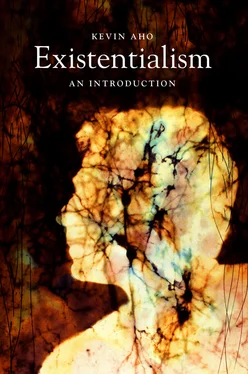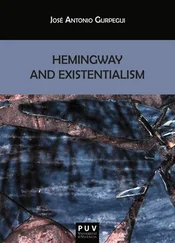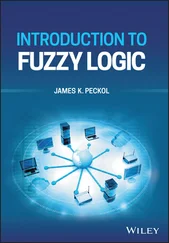Here we see Merleau-Ponty's critique of perception from the perspective of the realism vs. idealism debate. The realists generally take the mind-independent world as given, which then causally stimulates the sense organs of the perceiver. The idealists generally take the mind as given and the rules and concepts therein constitute and organize the world of perception. For Merleau-Ponty, both views not only assume that perceptions are initially made up of discrete sensations, they also both adhere to the same detached scientific view of the world as a geometrical space composed of objects in causal interaction. It is because both views interpret experience through these ready-made frameworks that they are incapable of grasping what Merleau-Ponty calls “the living nucleus of perception” (1962, 38), which is always prior to any theoretical assumptions about the mechanisms of experience.
This is why Merleau-Ponty's project begins from one's own living perceptions, where I am “first of all surrounded by my body, involved in the world, [and] situated here and now” (37). Our limited perceptual orientation provides us with different aspects of a unified background or whole, which is the “horizon of horizons” (330) that underlies all of my experiences and, through my engagement with it, allows me to make sense of the things that I perceive. And this unity is not constituted or mediated by the mind or intellect. It is given in the immediacy of sense perception — in seeing, hearing, touching — itself. Thus, “I do not have one perception, then another, and between them a link brought about by the [mind].” Rather, “each perspective merges into the other” against this unified background (329–330; see Wrathall 2009, 38). On this account, things acquire meaning because they are internally related to each other and are perceived from a particular perspective within this unified context. The tree I see from my office window, for instance, immediately presents itself from a particular embodied perspective that is itself only one aspect of a structured and coherent whole. What I see is that particular oak tree I sit under for shade on warm days when I want to read outside. The meaning of the tree depends upon where it stands in a complex interrelation to other things, to the office window, the sidewalk, the seasons, the campus lawn, and my own situated identity as a middle-aged college professor.
Meaning, then, is not an idea or mental representation. The meaning or significance of things emerges spontaneously through our situated and involved perceptions, through how we are oriented in public space, and by using, manipulating, and holding things from within this fleshly orientation. Merleau-Ponty offers the example of a smoker using an ashtray to illustrate this point. The meaning or significance of the ashtray is not the idea of the ashtray in the smoker's mind, an idea that is accessible only to the intellect. The meaning, rather, is given “in person” or “in the flesh” (319–323), in the smooth bodily familiarity that the smoker exhibits as he or she skillfully uses, holds, and handles the ashtray. Against the traditional view, then, meaning is not the result of some causal ‘psycho-physiological mechanism’ that produces discrete sensations. It is, rather, already bound up in the structured and unified weave of body, consciousness, and world. The things we perceive and comport ourselves with every day are meaningful or significant to us because of their place in a referential context and the situated ways in which we use and handle things within this context.
The human being, then, cannot be understood as a combination of two substances, mind and body. It is a unitary phenomenon. Any conceptual relationship we have with things is itself grounded in and made possible by the seamless dialectical synergy between incarnate consciousness and the world. Merleau-Ponty will refer to this synergy in terms of a “bodily schema” ( schéma corporel ) (1964a, 5), a reference to the pre-reflective sensory motor grip that we have on the world. This is why Merleau-Ponty refers to his project as a ‘phenomenology of origins.’ It is one that returns us to the pre-conceptual experiences that underlie objective thought and brings to light the complex web of relations that endows things with the meanings that they have. The world, on this view, is not something separate from me. It is the ambiguous, pre-objective field that I am already woven into in my everyday perceptual acts; it is “where the paths of my various experiences intersect, and also where my own and other people's intersect and engage each other like gears” (Merleau-Ponty 1962, xx).
This conception of being-in-the-world has helped to undercut one of the more dominant paradigms in contemporary Anglophone philosophy, the paradigm of ‘ naturalism .’ Due to tremendous advances in the empirical sciences in the nineteenth-century in areas such as zoology, physiology, and evolutionary theory, and, more recently, in the emerging field of neuroscience, naturalism has become more or less a default setting in contemporary philosophy. This view generally entails two assumptions, one epistemological and one metaphysical. The epistemological assumption contends that the detached theoretical standpoint and the procedures of empirical science constitute the best way to gain knowledge of intra-worldly things, including ourselves. The metaphysical assumption contends that the world — including our own thoughts, beliefs, and desires — is constituted by physical objects in causal interaction (Ratcliffe 2009, 330). On this account, as the German scientist Karl Vogt proclaimed at the end of the end of the nineteenth century, “Thoughts stand in roughly the same relation to the brain as gall to the liver or urine to the kidneys” (cited in Guignon 1983, 41). But this naturalistic interpretation uncritically assumes the standpoint of theoretical detachment. As a result, it overlooks the experiential world that we are engaged in every day. In this world of practical involvements, we do not encounter objects in a neutral or impartial way. Indeed, we do not encounter ‘objects’ at all because the term itself entails a view of entities as being separate and distinct from us (as ‘subjects’). As a being-in-the-world we are already involved with things that make sense, that are already rich with meaning, and this meaning is disclosed not through theoretical or conceptual analysis but in how we pre-reflectively handle, use, and manipulate things in our everyday practices.
In this way, Heidegger and Merleau-Ponty show that the primary relationship we have with things is not one of detachment and objectivity but of situated and skillful involvement in a referential context of meanings, and it is a contextual involvement that can never be made theoretically explicit. This is why Heidegger will refer to the standpoint of naturalism as one that is “ unworlded ” (1992, 217) because it abstracts out the situated and purposive meanings of being-in-the-world. But this does not mean that Heidegger and Merleau-Ponty are anti-science. In fact, Merleau-Ponty draws extensively on empirical science and neurological case studies in developing his own account of perception and embodied agency. What they are critiquing, rather, is the uncritical privileging of methodological detachment and objectivity, a view that has been largely uncontested in modern philosophy since Descartes. As Heidegger says, “What is messing up the real problematic is not just naturalism as some people think, but the overall dominance and primacy of the theoretical ” (cited in Sheehan 2006, 78). Such a standpoint invariably overlooks and takes for granted our embodied familiarity with things and the situated meanings of the experiential world that underlie all scientific thought. Merleau-Ponty makes this point explicit when he claims scientific thinking “must return to the ‘there is’ which underlies it; to the site, the soil of the sensible and opened world such as it is in our life and for our body … that actual body I call mine” (1964a, 160–161; cited in Langer 1989, xi).
Читать дальше












